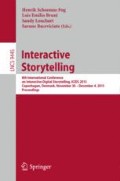Abstract
One of the challenges of interactive digital storytelling systems is to support the users’ experience of being able to freely roam open sandbox-like storyworlds, while at the same time maintaining control over the distribution and order of events in the mediated narrative. However, although several investigations into how to address this challenge have been conducted, there seems to be a lack of focused research into the possibilities of using the concept of space-time continuum to organize the mediation of events. This paper will thus describe ideas, concepts and examples of how space-time may be used to organize events while maintaining narrative engagement, by introducing a suggestion for a framework, which exploits the possibilities of space-time.
Access this chapter
Tax calculation will be finalised at checkout
Purchases are for personal use only
References
Aylett, R.: Narrative in virtual environments – towards emergent narrative. In: Aylett, R. (ed.) AAAI Symposium on Narrative Intelligence, pp. 83–86. AAAI Press, Salford (1999)
Roberts, D.L., Isbell, C., Riedl, M.O., Bogost, I., Furst, M.L.: On the use of computational models of influence for managing interactive virtual experiences. In: Spierling, U., Szilas, N. (eds.) ICIDS 2008. LNCS, vol. 5334, pp. 268–272. Springer, Heidelberg (2008)
Louchart, S., Swartjes, I., Kriegel, M., Aylett, R.S.: Purposeful authoring for emergent narrative. In: Spierling, U., Szilas, N. (eds.) ICIDS 2008. LNCS, vol. 5334, pp. 273–284. Springer, Heidelberg (2008)
Tanenbaum, J.: Being in the story: readerly pleasure, acting theory, and performing a role. In: Si, M., Thue, D., André, E., Lester, J., Tanenbaum, J., Zammitto, V. (eds.) ICIDS 2011. LNCS, vol. 7069, pp. 55–66. Springer, Heidelberg (2011)
Jenkins, H.: Game design as narrative architecture. In: Wardrip-Fruin, N., Harrigan, P. (eds.) First Person: New Media as Story, Performance, and Game, pp 118–130. MIT Press, Cambridge (2004)
Pinchbeck, D.: Dear Esther: an interactive ghost story built using the source engine. In: Spierling, U., Szilas, N. (eds.) ICIDS 2008. LNCS, vol. 5334, pp. 51–54. Springer, Heidelberg (2008)
Bevensee, S.H., Dahlsgaard Boisen, K.A., Olsen, M.P., Schoenau-Fog, H., Bruni, L.E.: Project aporia – an exploration of narrative understanding of environmental storytelling in an open world scenario. In: Oyarzun, D., Peinado, F., Young, R., Elizalde, A., Méndez, G. (eds.) ICIDS 2012. LNCS, vol. 7648, pp. 96–101. Springer, Heidelberg (2012)
Schoenau-Fog, H., Bruni, L.E., Khalil, F.F., Faizi, J.: Authoring for engagement in plot-based interactive dramatic experiences for learning. In: Pan, Z., Cheok, A.D., Müller, W., Iurgel, I., Petta, P., Urban, B. (eds.) Transactions on Edutainment X. LNCS, vol. 7775, pp. 1–19. Springer, Heidelberg (2013)
Wei, H., Bizzocchi, J., Calvert, T.: Time and space in digital game storytelling. Int. J. Comput. Games Technol. 8 (2010)
Branigan, E.: Narrative Comprehension and Film. Routledge, London (2013)
Sawhney, N., Balcom, D., Smith, I.: Authoring and navigating video in space and time. IEEE Multimedia 4, 30–39 (1997)
Schoenau-Fog, H.: Hooked! – evaluating engagement as continuation desire in interactive narratives. In: Si, M., Thue, D., André, E., Lester, J., Tanenbaum, J., Zammitto, V. (eds.) ICIDS 2011. LNCS, vol. 7069, pp. 219–230. Springer, Heidelberg (2011)
Minkowski, H., Sommerfeld, A.: Raum und Eeit. Vieweg + Teubner Verlag, Wiesbaden (1923)
Oatley, K.: Such Stuff as Dreams: The Psychology of Fiction. Wiley, Chichester (2011)
Author information
Authors and Affiliations
Corresponding author
Editor information
Editors and Affiliations
Rights and permissions
Copyright information
© 2015 Springer International Publishing Switzerland
About this paper
Cite this paper
Schoenau-Fog, H. (2015). Adaptive Storyworlds. In: Schoenau-Fog, H., Bruni, L., Louchart, S., Baceviciute, S. (eds) Interactive Storytelling. ICIDS 2015. Lecture Notes in Computer Science(), vol 9445. Springer, Cham. https://doi.org/10.1007/978-3-319-27036-4_6
Download citation
DOI: https://doi.org/10.1007/978-3-319-27036-4_6
Published:
Publisher Name: Springer, Cham
Print ISBN: 978-3-319-27035-7
Online ISBN: 978-3-319-27036-4
eBook Packages: Computer ScienceComputer Science (R0)

